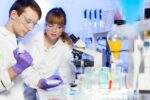PF Care, Therapies May Be Aided by New Atlas of Lung Development

Researchers have now compiled the most comprehensive molecular atlas, or roadmap, to date of healthy human lungs and their early development, leading to the identification of nearly 9,000 proteins whose production changes with age.
The data, open to the public through an online platform called LungMAP, are expected to help physicians and scientists — and patients, caregivers, and advocates — better understand what happens in lung diseases, and to aid in the development of potential therapies.
“This is a first-of-its-kind analysis of how the protein building blocks of the lung change as a child grows from birth to mid-childhood,” Gloria Pryhuber, MD, one of the study’s authors and a professor of pediatrics and environmental medicine at the University of Rochester Medical Center, in New York, said in a press release.
“This study provides a reference map for future investigators to work on certain subsets of the changing proteins, whether they be enzymes or structural proteins,” Pryhuber said, adding that some “may be studied as biomarkers of health or disease and others as potential targets for therapies.”
Geremy Clair, PhD, the study’s lead author at the Pacific Northwest National Laboratory (PNNL), part of the U.S. Department of Energy, said that the new lung atlas lays the groundwork for developing new treatments for many lung diseases.
“It has relevance for lung transplants, for cystic fibrosis in children, for pulmonary fibrosis [PF], as well as for idiopathic fibrosis,” Clair said.
“But that won’t happen overnight,” said Pryhuber, a neonatal physician. “Much work remains to be done.”
Analyses leading up to the creation of this molecular roadmap were reported in the study, “Proteomic Analysis of Human Lung Development,” published in the American Journal of Respiratory and Critical Care Medicine.
Current understanding of human lung development derives mostly from animal studies. However, these studies only “painted part of the picture,” Clair said. The newly generated data “provide insights on previously unknown details,” he said.
“We examined proteins in early development stages and we looked at how they are changing during the development of the organ,” Clair added.
Protein analyses were conducted in lung tissues collected from nearly 50 infants at 10 distinct time points, from birth to age 8.
The results showed that 8,938 different proteins were produced in the lungs and regulated in a coordinated fashion during lung development.
While the lungs and their local immune system are known to continue to develop after birth, these new data helped identify distinct molecular substages of lung development. They also helped researchers understand the extent of immune changes occurring as part of an individual’s normal development.
“The lung is not completely developed when a baby is born,” and “there is a little sac at the end of the airways — the major passages of the lungs — that has to divide into grape shapes called alveoli,” Clair said.
“Our study helps us better understand how this process works,” and provide answers for when that development “does not take place as expected,” Clair added.
Notably, continuous development of the lung’s immune system is a welcome phenomenon, as the lungs are one of the body’s main gateways for microbes.
The new molecular atlas is expected to provide a basis for further research of human lung formation and function, which may help improve treatment of several lung conditions, such as PF, and create artificial lungs.
“Right now, there is a shortage of donor lungs for people who need transplants,” Clair said.
“We need to find ways to regenerate lungs, or potentially make new lungs from cells of existing lungs,” he said.
Given technology’s rapid advancement, 20 years from now there may be tools able to use this molecular roadmap to “make this possible,” Clair added.
In addition, understanding normal lung development may help improve treatment for COVID-19 and its not yet fully understood long-term lung-related consequences.
“That may not happen right away,” Clair said, but “this study — along with others — will provide information that likely will assist in the development of therapeutic strategies.”
The creation of the new roadmap was part of the LungMAP project, a research initiative that involves scientists from around the world working together to develop a molecular atlas of the developing human lung.
In addition to researchers from PNNL and the University of Rochester, scientists from the University of Cincinnati Children’s Hospital, the University of Washington, and the University of Texas contributed to this project.









